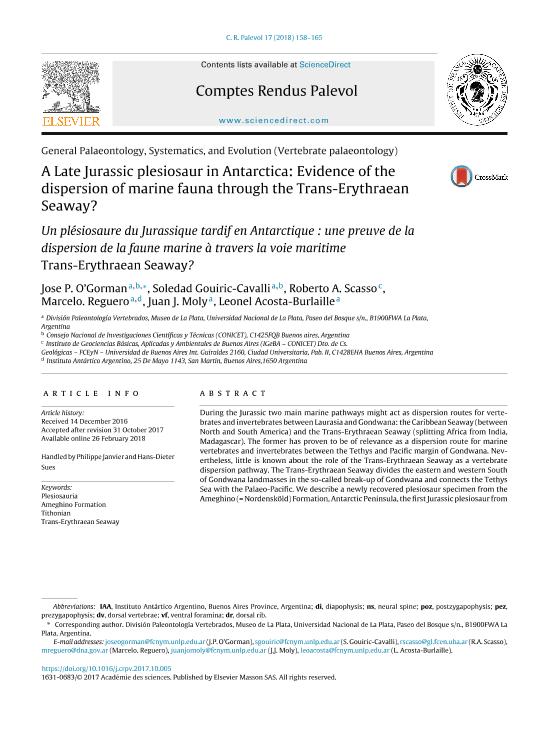Artículo
During the Jurassic two main marine pathways might act as dispersion routes for vertebrates and invertebrates between Laurasia and Gondwana: the Caribbean Seaway (between North and South America) and the Trans-Erythraean Seaway (splitting Africa from India, Madagascar). The former has proven to be of relevance as a dispersion route for marine vertebrates and invertebrates between the Tethys and Pacific margin of Gondwana. Nevertheless, little is known about the role of the Trans-Erythraean Seaway as a vertebrate dispersion pathway. The Trans-Erythraean Seaway divides the eastern and western South of Gondwana landmasses in the so-called break-up of Gondwana and connects the Tethys Sea with the Palaeo-Pacific. We describe a newly recovered plesiosaur specimen from the Ameghino (= Nordensköld) Formation, Antarctic Peninsula, the first Jurassic plesiosaur from Antarctica. We discuss the importance of this record regarding the hypothesis of marine vertebrate dispersion through the Trans-Erythraean Seaway. Pendant le Jurassique, deux principales voies maritimes ont pu servir d’itinéraires de dispersion des vertébrés et invertébrés entre la Laurasie et le Gondwana : la mer des Caraïbes (entre l’Amérique du Nord et l’Amérique du Sud) et la voie Trans-Érythréenne séparant l’Afrique de l’Inde–Madagascar. Il a été prouvé de manière pertinente que la première a été un itinéraire de dispersion pour les vertébrés et invertébrés marins. Mais on connaît peu de chose du rôle qu’a pu jouer la Trans-Érythréenne en tant qu’itinéraire de dispersion des vertébrés. La voie Trans-Érythréenne divise les masses continentales des parties est et ouest du Sud-Gondwana en formant la fracture appelée gondwanienne, qui connecte la Téthys au Paléo-Pacifique. Nous décrivons ici un spécimen de plésiosaure nouvellement répertorié dans la formation Ameghino (= Nordensköld) de la péninsule Antarctique, le premier plésiosaure découvert en Antarctique. Nous discutons l’importance de cette découverte en ce qui concerne l’hypothèse d’une dispersion marine de vertébrés par la voie Trans-Érythréenne.
A Late Jurassic plesiosaur in Antarctica: Evidence of the dispersion of marine fauna through the Trans-Erythraean Seaway?
Título:
Un plésiosaure du Jurassique tardif en Antarctique: une preuve de la dispersion de la faune marine à travers la voie maritime Trans-Erythraean Seaway?
O'gorman, Jose Patricio ; Gouiric Cavalli, Soledad
; Gouiric Cavalli, Soledad ; Scasso, Roberto Adrian
; Scasso, Roberto Adrian ; Reguero, Marcelo Alfredo
; Reguero, Marcelo Alfredo ; Moly, Juan J.; Acosta-Burlaille, Leonel
; Moly, Juan J.; Acosta-Burlaille, Leonel
 ; Gouiric Cavalli, Soledad
; Gouiric Cavalli, Soledad ; Scasso, Roberto Adrian
; Scasso, Roberto Adrian ; Reguero, Marcelo Alfredo
; Reguero, Marcelo Alfredo ; Moly, Juan J.; Acosta-Burlaille, Leonel
; Moly, Juan J.; Acosta-Burlaille, Leonel
Fecha de publicación:
03/2018
Editorial:
Elsevier France-editions Scientifiques Medicales Elsevier
Revista:
Comptes Rendus Palevol
ISSN:
1631-0683
Idioma:
Inglés
Tipo de recurso:
Artículo publicado
Clasificación temática:
Resumen
Palabras clave:
AMEGHINO FORMATION
,
PLESIOSAURIA
,
TITHONIAN
,
TRANS-ERYTHRAEAN SEAWAY
Archivos asociados
Licencia
Identificadores
Colecciones
Articulos(CCT - LA PLATA)
Articulos de CTRO.CIENTIFICO TECNOL.CONICET - LA PLATA
Articulos de CTRO.CIENTIFICO TECNOL.CONICET - LA PLATA
Articulos(IGEBA)
Articulos de INSTITUTO DE GEOCIENCIAS BASICAS, APLICADAS Y AMBIENTALES DE BS. AS
Articulos de INSTITUTO DE GEOCIENCIAS BASICAS, APLICADAS Y AMBIENTALES DE BS. AS
Citación
O'gorman, Jose Patricio; Gouiric Cavalli, Soledad; Scasso, Roberto Adrian; Reguero, Marcelo Alfredo; Moly, Juan J.; et al.; A Late Jurassic plesiosaur in Antarctica: Evidence of the dispersion of marine fauna through the Trans-Erythraean Seaway?; Elsevier France-editions Scientifiques Medicales Elsevier; Comptes Rendus Palevol; 17; 3; 3-2018; 158-165
Compartir
Altmétricas



